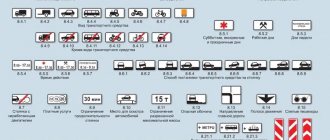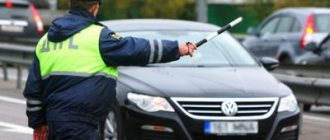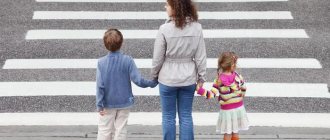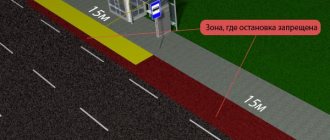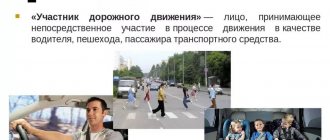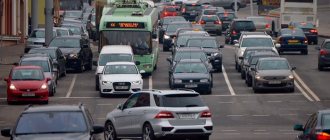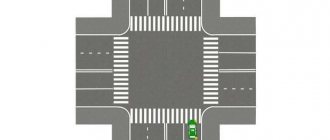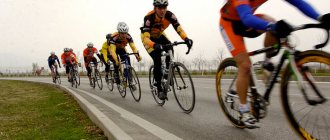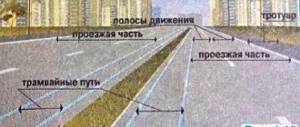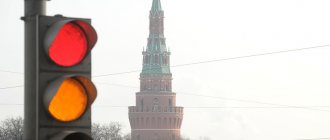Official interpretation for 2021
4.1. Pedestrians must move on sidewalks, pedestrian paths, bicycle and pedestrian paths, and if there are none, along the roadsides. Pedestrians carrying or carrying bulky objects, as well as persons using non-motorized wheelchairs, may move along the edge of the roadway if their movement on sidewalks or shoulders creates an obstacle for other pedestrians.
If there are no sidewalks, pedestrian paths, bicycle paths or shoulders, and also if it is impossible to move along them, pedestrians can move along a bicycle path or walk in one row along the edge of the roadway (on roads with a dividing strip - along the outer edge of the roadway).
When walking along the edge of the roadway, pedestrians must walk towards the movement of vehicles. Persons moving in wheelchairs without a motor, driving a motorcycle, moped, or bicycle, in these cases must follow the direction of travel of the vehicles.
When crossing the road and driving along the sides or edge of the roadway in the dark or in conditions of insufficient visibility, pedestrians are recommended, and outside populated areas, pedestrians are required to carry objects with reflective elements and ensure that these objects are visible to vehicle drivers.
Complete regulations on the norms and responsibilities of all road users. Download and get acquainted with the traffic rules online. Basic requirements for drivers of categories A, B, C, D, E. Preparation for passing exams on the Rules of the Road online, detailed description of road signs and markings. Traffic lessons.
4.1
.
Pedestrians must move on sidewalks or pedestrian paths, or, if they do not exist, along the sidewalks. Pedestrians carrying or carrying bulky objects, as well as persons using non-motorized wheelchairs, may walk along the edge of the roadway if their movement on sidewalks or shoulders creates an obstacle for other pedestrians. If there are no sidewalks, pedestrian paths or shoulders, or if it is impossible to move along them, pedestrians can move along a bicycle path or walk in a single row along the edge of the roadway (on roads with a dividing strip - along the outer edge of the roadway). When walking along the edge of the roadway, pedestrians must walk towards the movement of vehicles. Persons moving in wheelchairs without a motor, driving a motorcycle, moped, or bicycle, in these cases must follow the direction of travel of the vehicles. When driving along the side of the road or the edge of the roadway in the dark or in conditions of poor visibility, pedestrians are advised to carry objects with reflective elements and ensure that these objects are visible to vehicle drivers. 4.2
.
The movement of organized pedestrian columns along the roadway is permitted only in the direction of movement of vehicles on the right side of no more than four people in a row. In front and behind the column on the left side there should be escorts with red flags, and in the dark and in conditions of poor visibility - with lights on: in front - white, in back - red. Groups of children are allowed to drive only on sidewalks and pedestrian paths, and in their absence, along the roadsides, but only during daylight hours and only when accompanied by adults. 4.3
.
Pedestrians must cross the roadway at pedestrian crossings, including underground and overground ones, and in their absence, at intersections along sidewalks or curbs. If there is no crossing or intersection in the visibility zone, it is allowed to cross the road at right angles to the edge of the roadway in areas without a dividing strip and fences where it is clearly visible in both directions. 4.4
.
In places where traffic is regulated, pedestrians must be guided by the signals of a traffic controller or a pedestrian traffic light, and in its absence, a transport traffic light. 4.5
.
At unregulated pedestrian crossings, pedestrians can enter the roadway after assessing the distance to approaching vehicles, their speed and making sure that the crossing will be safe for them. When crossing a roadway outside a pedestrian crossing, pedestrians must, in addition, not interfere with the movement of vehicles and exit from behind a standing vehicle or other obstacle that limits visibility without making sure that there are no approaching vehicles. 4.6
.
Once on the roadway, pedestrians should not linger or stop unless this is related to ensuring traffic safety. Pedestrians who do not have time to complete the crossing must stop on the line dividing traffic flows in opposite directions. You can continue crossing only after making sure that further movement is safe and taking into account the traffic light signal (traffic controller). 4.7
.
When approaching vehicles with a blue flashing light (blue and red) and a special sound signal on, pedestrians are required to refrain from crossing the roadway, and pedestrians on it must immediately vacate the roadway. 4.8
. Waiting for a route vehicle and a taxi is allowed only on landing platforms raised above the roadway, and if there are none, on the sidewalk or side of the road. In stopping places for route vehicles that are not equipped with raised landing platforms, it is allowed to enter the roadway to board the vehicle only after it has stopped. After disembarking, it is necessary to clear the roadway without delay. When moving across the roadway to or from the stopping point of a route vehicle, pedestrians must be guided by the requirements of paragraphs 4.4 - 4.7 of the Rules.
Last changes
Clause 4.1 has been changed several times. And the latest innovation was in November 2014, when in the last paragraph, along with the recommendation for pedestrians to wear reflective vests, there was also an obligation to do this in the dark on the highway. And the recommendation itself was expanded to only when driving along the road, but also across it - when crossing.
When driving When crossing the road and driving along the sides or edge of the roadway in the dark or in conditions of insufficient visibility, pedestrians are recommended, and outside populated areas, pedestrians are required to carry objects with reflective elements and ensure that these objects are visible to vehicle drivers.
Earlier, in March 2014, the first 2 paragraphs of clause 4.1 of the Rules changed, when legislators introduced the term “bike and pedestrian path” - this was added to the list of road sections where pedestrians can walk.
And finally, the oldest change was in 2005 - then paragraph 3 changed:
Outside populated areas when driving along When driving along the edge of the roadway, pedestrians must walk towards the movement of vehicles. Persons moving in wheelchairs without a motor, driving a motorcycle, moped, or bicycle, in these cases must follow the direction of travel of the vehicles.
Comments to paragraph 4.1 of the traffic rules
So, these 4 paragraphs, first of all, prioritize sections of the road where pedestrians can walk. At the same time, you can go lower in this priority only if there is no special section for pedestrians or there is no way to walk along it.
The priorities are set as follows:
- pedestrians, according to clause 4.1, must walk on pedestrian paths or sidewalks or bicycle and pedestrian paths - all 3 sections are at the choice of the pedestrian,
- if the above sections are not available or it is not possible to walk along them, then you can walk along the side of the road,
- when there is no shoulder either, then the pedestrian’s foot can step onto the bicycle path (if there is one, of course) or walk along the edge of the roadway, but only in one row and only towards the flow (on the left side, if the traffic is two-way). Here, too, the pedestrian has a choice: either a bicycle path or a carriageway.
Definitely, if there is a bicycle path and a pedestrian path nearby, as is often the case, then pedestrians are prohibited from walking along the bicycle path, even if the quality of the surface there is better... And even with a stroller.
How do you mean “no opportunity”?
The traffic regulations in force for 2021 do not disclose this term in any way. In particular, we are faced with the following questions:
- if the coating is all in holes, potholes,
- if the coverage is simply slightly worse than in a lower priority area,
- if there is a big puddle in front of us...
And such “ifs” can be listed endlessly.
Clearly, this question is of practical importance - accidents are not uncommon when a car hits a pedestrian on the roadway. Yes, the driver will be (partially) to blame for such an accident in any case (see case law below). But if the pedestrian did not have the right according to the traffic rules to move along the roadway, that is, clause 4.1 was violated, then this will play into the hands of the opposing opponent of the court case.
And the persons considering the case, as a rule, consider it out of personal conviction, and approach the issue objectively. So, if you just wanted to walk along the roadway or bike path because the quality of the road here is a little better, then there was no objective impossibility of moving along the pedestrian road. Inconvenient, but not impossible.
Important note!
- This article provides basic information, but each case is different.
- In 92% of all situations there are important nuances that can affect the outcome of the entire case.
- An experienced lawyer will study all the materials of the case and indicate in which direction to move.
Therefore, our website employs on-duty legal consultants who delve into each case and are aimed at solving it.
Ask a Question
or consult toll-free (Moscow), (St. Petersburg), 8 (all of Russia).
Penalty for violation 4.1
There is no separate fine for violating paragraph 4.1 of the Traffic Rules in 2021. In general, the Code of Administrative Offenses does not diversify pedestrian violations based on specific violations of traffic rules. There are 2 articles and 4 types of punishment depending on the consequences that resulted from one of the violations of pedestrian duties:
- violation by a pedestrian of any clause of the traffic rules relating to him, including 4.1 - 500 rubles fine or warning (part 1 of article 12.29 of the Administrative Code),
- also any violation, but provided that it entailed the creation of an obstacle to other road users, including cars - a fine of 1,000 rubles (Part 1 of Article 12.30 of the Administrative Code),
- and if such a violation led to slight or moderate harm to the health of other participants - 1,000 - 1,500 rubles (Part 2 of Article 12.30 of the Administrative Code),
- and if the violation causes death, then the pedestrian faces a criminal charge for causing death by negligence.
Regarding point 2, you need to understand what an obstacle is. According to traffic rules, to interfere is to force another participant to change the speed or direction of movement.
Comments to paragraph 2.1.1
Take, for example, the owner of a personal vehicle. What documents should he have with him and, at the request of a police officer, hand over to him for verification:
a driver's license of the appropriate category or a temporary permit (if the driver's license has been withdrawn); car registration certificate (it also contains your details - full name, home address); technical inspection certificate; insurance policy of compulsory civil liability insurance of the vehicle owner. What if the car doesn’t belong to you? Then, in the absence of the owner, you must also have with you a power of attorney for the right to dispose of this car. In addition, your insurance policy must include your details unless the policy provides for an unlimited number of permitted drivers.
Now about the cargo being transported. If the cargo has a “marketable appearance”, then, of course, there must be documents confirming the origin and ownership of this cargo. But even ordinary boards that you take to your dacha can arouse interest from regulatory authorities. Therefore, it is recommended to always save cash receipts and sales receipts.
A trailer can be used to transport cargo. At the same time, we must not forget that a trailer is nothing more than a vehicle. Therefore, you must have documents confirming your ownership or control of this trailer.
Trailers can be small and light, large and heavy. According to the “Rules for passing qualification exams and issuing driver’s licenses”, drivers who have the right to drive vehicles of categories “B”, “C” and “D” can drive these vehicles also with a trailer, the maximum permitted weight of which does not exceed 750 kg.
What if it exceeds? Then for vehicle drivers:
categories “C” and “D”: the driver’s license must contain a permit (you must pass a driving test with a trailer); category “B”: - if the permitted maximum weight of the trailer does not exceed the weight of the curbed vehicle, and the total permitted maximum weight does not exceed 3500 kg, then it is enough to have a permit on the driver’s license; - if the previous conditions are not met, then you will have to take a driving test with a trailer and obtain a permit. Note: drivers are not required to hand over documents to military traffic police officers, road maintenance service employees, or those on duty at railway crossings and ferry crossings, although all orders of these persons regarding traffic regulations are mandatory for drivers.
Penalties to clause 2.1.1
Despite this, the Code of Administrative Offenses of the Russian Federation establishes responsibility for driving a passenger taxi, bus or truck designed and equipped for transporting people, with more than eight seats (except for the driver), a vehicle intended for transporting dangerous goods - which have not passed the state technical inspection or technical inspection. The driver can be fined 500-800 rubles (Part 2 of Article 12.1 of the Code of Administrative Offenses of the Russian Federation).
Problem for paragraph 2.1.1
Should the driver affix a technical inspection ticket to the windshield?
1 – must 2 – must, in the lower right corner 3 – must not
Decision :: By Decree of the Government of the Russian Federation of March 18, 2012 No. 264 (came into force on April 13, 2012), the requirement for the mandatory presence of a state technical inspection coupon in the lower right corner of the windshield was excluded from paragraph 2 of the Basic Provisions. The same document abolished the requirement to have a coupon with you.
Answer: 3
Arbitrage practice
- The pedestrian walked along the edge of the roadway and in the direction of traffic, and not against it, thereby violating paragraph 4.1 of the traffic rules. The bus driver hit a pedestrian, thereby violating clause 10.1 and causing injuries to the pedestrian that cost the latter his life. The sentence in the criminal case was assigned to the bus driver, since the cause-and-effect relationship established that the violation of 10.1 by the bus driver, and not 4.1 by the pedestrian, led to the death of the pedestrian. Appeal decision No. 22-1458/2014 upheld the decision.
- Decision No. 12-127/2017 of the Belgorod District Court left without satisfaction the pedestrian’s complaint about the alleged violation of paragraph 4.1 by the inspector for the lack of reflective elements in the dark outside the populated area.
- Decision No. 2-13/2016 of one of the Altai courts also left the claim against the road service unsatisfied. The pedestrian complained that he was forced to walk along the road, contrary to paragraph 4.1 of the traffic rules, because the sidewalk was not cleared of snow, which is why he was hit by a car and suffered serious injury. In the lawsuit, the pedestrian asked the court to recover moral damages from road workers for inaction in removing snow. The court rejected the claim.
- The traffic police officer issued a fine to the pedestrian for violation of 4.1 on the basis that he was walking along the side of the road in the direction of travel, and not against the direction of travel. The pedestrian’s arguments during the appeal that it was impossible to cross to the other side of the road because the graders, when clearing the snow, formed a shaft about a meter high, the court did not take into account and upheld the decision with the fine.
Fines for violation 2.3.1
For deviation from the requirements of this paragraph of the traffic rules, a number of fines are provided - they are established by article 12.5 of the Code of Administrative Offenses.
- For driving with any malfunctions, with the exception of those listed below, general liability is established - a fine of 500 rubles or a warning (Part 1 of Article 12.5). And below are the faults for which a more stringent sanction is provided.
- If your brakes, steering system or coupling device are faulty, and you continue to drive with such a breakdown, then the fine for violating 2.3.1 of the traffic rules in this part will be the same 500 rubles without the possibility of receiving a warning. Part 2 of the article
- For red lights ahead or for the lights of lighting devices, the color and mode of operation of which violate the rules, a deprivation of rights for 6-12 months is provided, plus confiscation of devices with such lights. Part 3.
- There is a fine of 500 rubles for driving with tinting. Part 3.1.
- For driving with special signals - imprisonment for 1-1.5 years with confiscation of special signals. Part 4.
- Illegal driving with a taxi or a disabled person's identification sign - a fine of 5,000 rubles and confiscation of the sign. Part 4.1.
About the color and operating mode of lights
Note. Part 3 of Article 12.5 of the Code of Administrative Offenses is applied in practice if you have installed lamps in your car that do not match the type of headlight
For example, xenon lamps in headlights designed for halogen ones.
Prosecution under this article for violation of 2.3.1 in this case is illegal, because according to the letter of the law, the driver must be punished for non-compliance with both the color and operating mode of the headlights. But in the case of mismatched headlights, neither one nor the other is most often damaged.
According to traffic regulations, the color of the lights must be white, yellow or orange. And the operating mode according to the Technical Regulations of the Customs Union On the safety of wheeled vehicles is flashing or constant. Therefore, in the case of LED lamps or xenon in halogen headlights, none of the conditions are violated. However, in almost 100% of cases the court will impose this sanction. Alas, the practice of law enforcement regarding this part of violation of paragraph 2.3.1 of the traffic rules is as follows.
Evacuation to impound lot
It is provided if you are stopped on the road by a traffic police officer with the following non-working components:
- the brakes don't work,
- steering system is faulty,
- The hitch does not work and you are towing a trailer.
